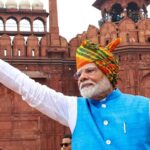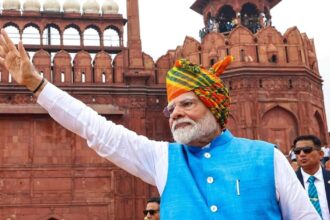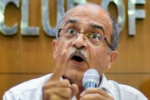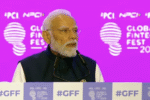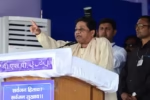The minister shown holding the lotus-shaped loudspeaker on a poster issued by the JNU Students Union (JNUSU) poster is External Affairs Minister Dr. S Jaishankar. One might believe that Dr S. Jaishankar is the pillar of strength of PM Modi’s foreign policy, or of Indian diplomacy; or a worthy alumnus of the Jawaharlal Nehru University or of the School of International Studies at JNU — where he studied international relations and more. JNUSU seems to think otherwise – as indicates a poster it issued on October 5 and shared on X. It announced protesting against EAM’s visit to the university for the Aravali Summit to celebrate seven decades of the School of International Studies (SIS) at JNU. His own university. The JNUSU’S own university.
The summit, part of the SIS@70 celebrations, marked the School’s seven decades in academic excellence, hosting policy makers, scholars and practitioners who would reflect on India’s role in the world ahead of 100 years of Independence in 2047. It featured alumnus Dr. Jaishankar as the keynote speaker. The international conference, themed ‘India and the World Order: Preparing for 2047′ was organised as part of the celebrations.
Ideally, for the JNUSU, the visit of this alumnus of JNU, who is a shining image of its rigour and scholarship in his field — should be or was an opportunity for exploration — with an open mind, with inquiry and query. It was not.
The art of using protest-motifs
The motif of a lotus-shaped loudspeaker appears attractive and pretty when it comes to depicting the idea of freedom of speech. However, when a minister in PM Modi’s cabinet is depicted holding the lotus-shaped loudspeaker, the concealed meaning pops itself out and makes itself heard — loud and clear. It tends to be quickly-associated with the aspect of Hindu “propaganda”, with a political party, with Hindu, with “Hindutva”. The Left is good at protest-art. It is even better in selecting motifs for protest-art and timing of use.
Dr. Jaishankar — an alumnus of SIS JNU at the forefront of shaping India’s journey in international politics in the Global South for six years in the government and four decades in different roles in diplomacy and international relations — was branded as Modi’s parrot. And his perceived style or character of work — “Hindu Nationalist” — a description used as a pejorative.
The Left is more than good at protest art, particularly, when it is used on a poster where Prime Minister Narendra Modi is mentioned — stiffly — as just “Modi” and his minister as “Modi’s parrot.” When the Left’s imagery concerns the BJP, creativity is recycled, choice becomes easy, and the lotus-shaped loudspeaker imagery does not surprise. It seems familiar. Was it on the cover of a leading news magazine of the Left? One might think…
The JNUSU tagged the official handle of the Ministry of External Affairs in the post. Names of three of the four members of the JNUSU are mentioned on the poster. The fourth member represents RSS-affiliated Akhil Bharatiya Vidyarthi Parishad and is excluded.
‘Modi’s yes man’ and not ‘own’ for JNUSU
Through this Summit, and its continuation in the coming years, the SIS and JNU, clearly, are making efforts to converge scholarship, practice and insights on India’s economic growth, technological innovation, migration, diaspora, civilisational identity and other aspects and converging the strengths — in partnership with the Ministry of External Affairs. On the other hand is JNUSU. It seemed to have a problem with the minister himself and chose to protest against his visit.
The Left celebrates and welcomes some beautifully. In 2005, the Left-dominated JNUSU welcomed the visiting Venezuelan president, Hugo Chavez. The campus echoed with the socialist anthem, “El pueblo unido jamas sera vencido” at his arrival. Years later, swiftly forgetting the United States of America for “imperialism” and “capitalism” — which became the subjects, rightly, of the Left’s ire during the US military action in Iraq and Afghanistan in the early 2000s, the Left-dominated campus celebrated the victory of Barack Obama in the US presidential election. For good reasons.
Then, political dominance at the campus played a role in the JNU-Left welcoming actor Deepika Padukone at a protest that suited its own agenda. And for this, they seemed to conveniently shove aside her problematic series of films — many of which thrive on women’s objectification, sexualisation of women, and other aspects the Left stands up against in different landscapes.
Yet, they chose to oppose the visit of Dr S. Jaishankar — the leader now synonymous with India’s assertive and humanitarian foreign policy, and ascendency, that has created space for India’s approach as a ‘Vishwa Mitra’ — the friend of the world.
As the poster indicates, Jaishankar does not meet their expectations on issues related to Palestine. That’s fair. And because: “as India’s EAM, rather than acting with his own mind and astute conscience, with the skills he must have acquired at SIS/JNU, S. Jaishankar has largely acted as a yes man parroting Modi’s Hindu Nationalist Foreign Policy, leaving a trail of disasters from our neighbourhood to our relationship with other Great powers.”
While taking bold stands is part of JNU politics, opposing Modi, for JNUSU, opposing a minister of key importance in the Modi cabinet, seemed to bear more importance than celebrating JNU’s own narrative power, intellectual legacy, and dialogue.
While the Left-dominated JNUSU has the right to protest and dissent at its own campus, one wonders why certain stands taken by Dr. Jaishankar were not first taken up for a debate, or exploration and questions, on
the day of Dussehra. That would be a day apt for debate and brainstorming and not for a political clash with the ABVP — that the Left considers and brands as “lumpens”.
Disconnecting with the best
Dr. Jaishankar’s scholarship and practice would compel any learner to keep ideological differences aside, and welcome him to the campus. His work and stands undergo criticism in the media and social media, just
as any other minister’s do and should. Yet, it would be profoundly foolish to let views on a singular foreign issue dominate the negative perception of the mind-force behind the spiralling-trajectory of India’s evolving role in diplomacy and world affairs.
During Dr. Jaishankar’s tenure, India has made considerable progress in multilateral engagement in the Global South, in discourse on Pakistan, reinforcement of relations through an Indic outlook with nations in
SouthEast Asia, in maneuvering India’s actions with stronger partnerships in the Middle East. In taking stands on Russia and Ukraine keeping India’s interests central; dampening the West’s criticism of New Delhi’s stand on procurement of crude oil from Moscow; in the assertion of respecting the “red lines” amid US tariff
issues, and in steering through related challenges, giving Skill India, Startup India, Digital India, a philip on the global stage.
Dr. Jaishankar’s continuing learning in the field is the essence of his practice, in which aspect the SIS has played a significant part. As an alumnus, he is of immense value — as a scholar, practitioner, policy maker, minister, and as India’s voice on the global platform. As an alumnus, he is an outcome of the academic rigour, leadership in relevant breakthroughs, with decades dedicated to teaming up with scholars, diplomats, policymakers, and now, colleagues in the government.
All these aspects must ideally compel any learner — in any field — to detach from a politicised view and focus on interconnections that Bharat can soar towards 2047 with.
The JNUSU poster made it seem that it was not in alignment with the evolving thought process of the institution and the school that invited Jaishankar. And this should be a cause of concern for JNU, higher educational institutions, society, the government, and learners, collectively.
The other grouse mentioned on the JNUSU poster: “JNU Admin cites that it doesn’t have funds to address crumbling infrastructure in SIS, as well as in the campus, but has money to spend on an extravaganza at this summit.”
The Summit and celebration are in collaboration with the Ministry of External Affairs and Chintan Research Foundation — under the leadership of Prof. Santishree Dhulipudi Pandit, Vice Chancellor, JNU, and an alumnus of the School. She has earlier stated the importance of political power, narrative power and intellectual sovereignty. As the first woman VC at the university, she prefers the gender neutral title “Kulguru” and is known for supporting Indic values in education. It is well-known that sections of the Left students’ groups and media supporting them have been opposed to Pandit’s views and decisions on different occasions.
A month before the University polls, the idea to oppose Jaishankar’s visit might seem attractive to the Left student groups. It has punch – like the kind of punch experienced perhaps in opposing ABVP or the RSS or the BJP. But this stance defeats the vision of the SIS and JNU to “reinforce the legacy of the SIS as a hub of intellectual independence and global engagement, while fostering forward-looking dialogue on India’s trajectory in global affairs” through this Summit.
Dr. Jaishankar’s speech — the illustrious Indic’s insights
The fast-evolving world requires a new outlook from learners that JNU, being Left-dominated, is keeping itself open to explore, to make diverse views reach learners.
Dr. Jaishankar’s speech at the Summit must be read once, carefully, by learners in not only the social sciences, the humanities, and international relations, but across the wide spectrum of academics in higher studies. It is of significance for analysts, professionals, experts and practitioners, as life-long learners across work domains directly-contributing to and interacting with the evolving landscape of Bharat in the shifting global dynamics.
It honours the aspect of institutional journey. Several paragraphs reveal how the different dimensions of the fields he studied at JNU — (where he did his MA, MPhil and PhD) interacted through dynamic interconnections during different assignments — over different phases — and continue to during his illustrious career. “Looking back, perhaps the schooling in SIS also helped shape many other traits, including the inclination to engage and utilize the academic community and its platforms. And perhaps in a way, I could blame my books on all of you!” he said.
It reveals the subtle and direct interplay of his studies, training and practice in his engagement with the world. The aspect is of great importance to learners in all fields in a swiftly-evolving world order and global job market. Paragraph 4 of his speech is an engaging reflection of this aspect.
In a localised context to JNU students’ politics, understanding the depth of the issues discussed and highlight by Jaishankar in India’s contexts, holds the key to understanding how disconnected the Left student groups at JNU are becoming and continue to be, from the concept and dynamics of Viksit Bharat. In fact, the more this speech is read, the more it becomes clear how the JNUSU choice — to go for a symbolic protest against Jaishankar’s visit owing to India’s stand on a singular issue — could play a role in distancing a chunk of imaginative young minds from the future of India’s own narrative and India’s “power of ideas”.
He adds, “…A third of global manufacturing has moved to a single geography, with attendant consequences for supply chains. There is rising anti-globalization sentiment in many societies.” These two sentences from Jaishankar’s speech represent aspects of global challenges that the Left student groups, during the last two decades, have given time and thought to. At a time when India’s own role is evolving in respect to these aspects, JNUSU, representing JNU and the Left, must participate constructively and engage.
Dr Jaishankar stated in his speech: Consider the global landscape now and let us reflect on the intensity of the transformation and their implications…” Next: he urged SIS to “consider shifting gears and undertaking the task of addressing the agenda of Viksit Bharat.” This is of deep importance because the School has shaped and contributed to India’s diplomatic capabilities for 70 years. Future challenges that India faces would continue to derive strength from the force of ideas, solutions and problem-solving through the expertise, practice and capabilities the SIS shapes. JNUSU must connect itself with the creativity SIS is displaying.
Diversity in politics and ideologies at Indian universities is a breathing and thriving symbol of India’s democratic diversity. However, an ideology should not become the medium or reason to distance learners from the idea of Viksit Bharat, a culturally-resurgent India, positive thought shaping development and social dynamics, in the evolving global stage and context. Lotus loudspeakers for motifs are fine. Melancholy lotus-eating should now become a thing of the past.


